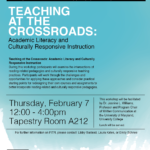Does Reading Matter? FIG Meeting #3
Facilitator: Michelle Gabay,
English (Esther.Gabay@kbcc.cuny.edu)
for the Faculty Initiative on Teaching Reading (FITR)
Does Reading Matter? FIG May 20, 2020 at 12:00
Blackboard Discussion Board for Close Reading
Goals:
- Learn how to use and embed active learning and reading technology into your emergency online course and lessons.
- Think about ways to use the Bb Discussion Board feature for after reading assignments, assessments, or activities.
- Determine what your reading objectives are and design a reading assignment, assessment, or activity that helps students practice or meet this goal(s).
- Walk away with some idea about you might craft a reading assessment, assignment, or activity using the Bb Discussion Board.
We took a brief tour of a Bb course showing one example of how one might integrate the Discussion Board into (DB) a weekly lesson to continue to foster active reading. We looked a few Discussion Board forums that are grounded in reading and explored the placement and design of the DB assignment.
DB example assignments looked at the objective, the focus of the activity and the context of the activity.

We also looked at was Beth King’s (Anthropology) multi-modal Blogs (based on students’ independent reading/research). Students were asked to find an article related to the topic of the week’s lesson. They needed to summarize the article and discuss how it related to the to an Anthropological concept taught in the module. To enhance students’ engagement with their source, students were also asked to embed an image as their header that reflected the theme and subject of the blog. The activity asks students to use their prior learning from the class to engage in a mini-research project. It both reinforces what students have already learned from the course and teaches them how to build upon their knowledge through research, and gives students a place to show understanding of the content/topic of the lesson by finding an article that applies to the conceptual framework being taught. Adding the visual component, asks students to continue to demonstrate their understanding of the researched text through a visual representation.
After we looked at these examples, the group spent a few minutes writing and reflecting:
Think about one text you like to use or that you regularly use in your class. What text is it? Why do you assign this reading in your classes? What is it you want your students to gain from this text? What objective do you want your students to reach by assigning this text? How might you design a Discussion Board activity that would help students reach this objective.
The purpose of this prompt was to give instructors a chance to think about their own intentions and text selections so they can better frame their reading and the reading work they want to do with their students engage in.
We spent the remainder of the session just talking about the role of the DB and some issues we were having managing it as part of the coursework.
Some instructors have been finding it difficult to figure out when to chime in and respond. Occasionally, instructors see their students naturally engaging in threads, where conversations seem to flow without the need for the instructor to intervene. When does the instructor stifle the conversation and when is the instructors interjection helpful? It was noted, that sometimes, these organic discussions reflect the most student-centered experience, since students are really leading these discussions. But others noted that many students do not engage in the social learning component as willfully.
Some suggestions to foster peer to peer engagement:
- Set a minimum word limit for responses
- Instructor contributes to thread with positive broad feedback
- Instructor engages in the conversation
- Provide step by step instruction for replies
- Provide examples of different quality replies
Other notable suggestions included:
- Take it slow. Don’t let the tech take control.
- Pick the tech that works for you and master it (continuity)






